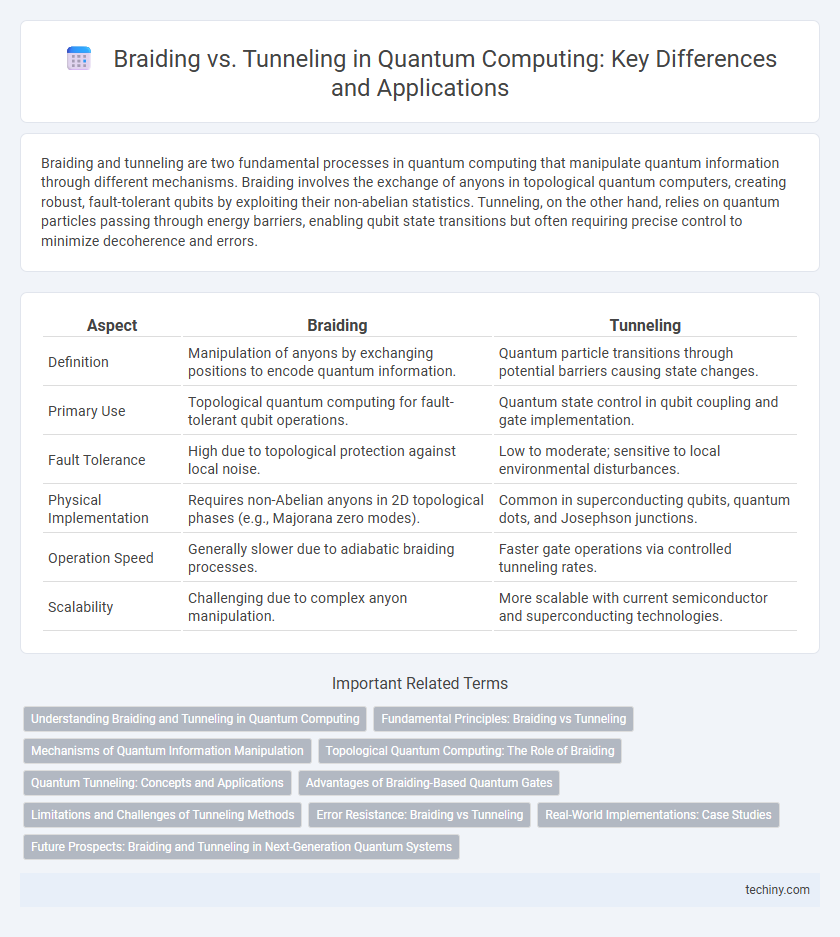Braiding and tunneling are two fundamental processes in quantum computing that manipulate quantum information through different mechanisms. Braiding involves the exchange of anyons in topological quantum computers, creating robust, fault-tolerant qubits by exploiting their non-abelian statistics. Tunneling, on the other hand, relies on quantum particles passing through energy barriers, enabling qubit state transitions but often requiring precise control to minimize decoherence and errors.
Table of Comparison
| Aspect | Braiding | Tunneling |
|---|---|---|
| Definition | Manipulation of anyons by exchanging positions to encode quantum information. | Quantum particle transitions through potential barriers causing state changes. |
| Primary Use | Topological quantum computing for fault-tolerant qubit operations. | Quantum state control in qubit coupling and gate implementation. |
| Fault Tolerance | High due to topological protection against local noise. | Low to moderate; sensitive to local environmental disturbances. |
| Physical Implementation | Requires non-Abelian anyons in 2D topological phases (e.g., Majorana zero modes). | Common in superconducting qubits, quantum dots, and Josephson junctions. |
| Operation Speed | Generally slower due to adiabatic braiding processes. | Faster gate operations via controlled tunneling rates. |
| Scalability | Challenging due to complex anyon manipulation. | More scalable with current semiconductor and superconducting technologies. |
Understanding Braiding and Tunneling in Quantum Computing
Braiding in quantum computing involves manipulating anyons through exchanges that change the system's quantum state non-trivially, enabling fault-tolerant quantum gates essential for topological quantum computation. Tunneling refers to particles overcoming energy barriers to move between quantum states, impacting coherence and error rates in qubits by affecting quantum state transitions. Understanding the distinct roles of braiding and tunneling helps optimize quantum algorithms and improve qubit stability in advancing topological quantum computers.
Fundamental Principles: Braiding vs Tunneling
Braiding in quantum computing relies on the topological manipulation of anyons, where exchanging their positions alters the quantum state in a robust, fault-tolerant manner essential for topological quantum computation. Tunneling involves quantum particles passing through potential barriers due to wavefunction overlap, enabling coherent quantum transitions but often suffering from decoherence and error susceptibility. The fundamental distinction lies in braiding's topological protection against local disturbances, whereas tunneling processes depend on precise control of quantum amplitude probabilities without inherent error correction.
Mechanisms of Quantum Information Manipulation
Braiding manipulates quantum information by topologically exchanging non-abelian anyons, creating robust, fault-tolerant quantum gates through their intertwined worldlines. Tunneling involves quantum particles passing through energy barriers, enabling controlled superpositions and entanglement essential for qubit state transitions. Both mechanisms exploit different quantum properties: braiding relies on topological order while tunneling leverages quantum coherence and energy-level manipulation.
Topological Quantum Computing: The Role of Braiding
Braiding operations in topological quantum computing manipulate anyons--quasiparticles with non-abelian statistics--by exchanging their positions to encode and process quantum information robustly against local perturbations. Unlike tunneling, which involves quantum particles passing through potential barriers, braiding leverages the global topological properties of the system to achieve fault-tolerant quantum gates. This fault tolerance arises from the inherent stability of braiding paths, making topological quantum computers highly promising for scalable, error-resilient quantum computation.
Quantum Tunneling: Concepts and Applications
Quantum tunneling enables particles to pass through energy barriers that are classically insurmountable, playing a crucial role in the operation of quantum computers by facilitating qubit state transitions and error correction mechanisms. This phenomenon underpins the design of ultra-sensitive tunneling junctions and quantum dots, which enhance coherence times and computational fidelity. Practical applications span from tunneling-based qubits in superconducting circuits to optimizing quantum annealing processes in problem-solving tasks.
Advantages of Braiding-Based Quantum Gates
Braiding-based quantum gates offer enhanced fault tolerance by leveraging non-Abelian anyons, which inherently protect quantum information through topological properties, reducing susceptibility to local decoherence. This method enables more stable and robust quantum operations compared to tunneling-based gates, which rely on delicate control of particle tunneling that is prone to noise and error. The topological nature of braiding operations facilitates scalable quantum computing architectures with lower error rates and improved coherence times.
Limitations and Challenges of Tunneling Methods
Tunneling methods in quantum computing face significant limitations such as increased error rates due to environmental decoherence and the difficulty of maintaining stable quantum states during tunneling processes. These challenges hinder the scalability and reliability of quantum devices, as precise control over tunneling paths remains technologically complex. Furthermore, tunneling-based qubits often suffer from shorter coherence times compared to braiding methods, limiting their practical application in fault-tolerant quantum computation.
Error Resistance: Braiding vs Tunneling
Braiding in quantum computing offers superior error resistance by leveraging non-Abelian anyons, which encode information topologically and remain stable against local perturbations. Tunneling-based approaches rely on quantum states that are more susceptible to decoherence and environmental noise, leading to higher error rates. Consequently, braiding provides a more robust framework for fault-tolerant quantum computation compared to tunneling mechanisms.
Real-World Implementations: Case Studies
Braiding and tunneling are key techniques in topological quantum computing, with braiding exhibiting higher fault tolerance by manipulating anyons' paths to encode qubits. Real-world implementations, such as Microsoft's pursuit of Majorana-based qubits, emphasize braiding's robustness in stabilizing quantum information against decoherence. Meanwhile, tunneling methods, exemplified by recent experiments in semiconductor-superconductor heterostructures, demonstrate fast gate operations but face challenges in maintaining long-term coherence, highlighting the trade-offs in practical quantum device engineering.
Future Prospects: Braiding and Tunneling in Next-Generation Quantum Systems
Braiding of anyons in topological quantum systems offers fault-tolerant qubit operations by exploiting non-Abelian statistics, which could enable scalable quantum computing architectures with inherent error resistance. Tunneling processes, integral to quantum gate implementations, provide faster qubit manipulation but face decoherence challenges limiting coherence times in next-generation devices. Future quantum technologies aim to hybridize braiding's robustness with tunneling's speed to achieve high-fidelity, scalable quantum processors.
braiding vs tunneling Infographic

 techiny.com
techiny.com